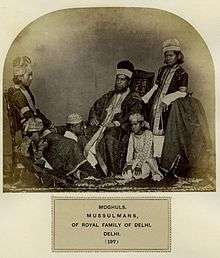Mughal people
The Mughals (Persian: مغول; Urdu: مغل; Arabic: مغول, also spelled Moghul or Mogul) are a number of culturally related clans of the Indian subcontinent.[1] They are descended from the various Central Asian Turk and Mongol[2] tribes that settled in the region.[1] The term Mughal (or Mughul in Persian) literally means Mongolian.[3]
 A photo from The People of India, published from 1868 to the early 1870s by W. H. Allen Ltd, for the India Office. Bahadur Shah II is sitting on that royal throne. | |
| Regions with significant populations | |
|---|---|
| South Asia | |
| Languages | |
| Urdu and Hindi Persian (formerly) | |
| Religion | |
| Islam | |
| Related ethnic groups | |
| Moghols, Mongols |
History and origin
During the time of the Mongol Empire in the 13–14th century, the army of Genghis Khan swept across Central Asia and into Persia. Over subsequent centuries, descendants of these soldiers inter-married with Persian and Turkish Muslims, converted to Islam, and adopted the Persian language and culture. Conflict between India and the Mongols has been recorded from the time of Genghis Khan to Timur to Babur. The Delhi Sultanate (1206–1526) faced nearly annual Mongol onslaughts from 1297 to 1303 when the Doab was sacked, and what is now Pakistan was under continual Mongol occupation. Indian and Indo-Persian sources referred to the invaders as Mughal, derived from Mongol. During the 16th century, the Turko-Mongol conqueror Babur brought most of northern India under Mughal rule, establishing an empire that would endure until the mid-19th century. As the ruling class, the Mughals lived mainly in cities along with other Muslims. They were traditionally known for their skill at horsemanship, archery, wrestling, and a meat-heavy diet.[4]
In North India
In North India, the term Mughal refers to one of the four social groups that are referred to as the Ashraaf.[5]
Notable Mughal
- Babur, founder of Mughal Empire
- Akbar, Emperor of Mughal Empire
- Jahangir, Emperor of Mughal Empire
- Shah Jahan, Emperor of Mughal Empire
- Aurangzeb, Emperor of Mughal Empire
- Bahadur Shah Zafar,
- Mirza Mughal, Mughal prince
- Mirza Abu Bakht, Mughal prince
See also
References
- Dictionary Of Geography. Wisconsin: Houghton Mifflin. 1997. ISBN 0-395-86448-8.
- Liz Wyse and Caroline Lucas (1997). Atlas Of World History. Scotland: Geddes & Grosset.
- Collins Compact Dictionary. Glasgow: HarperCollins. 2002. ISBN 0-00-710984-9.
- John Keay (2000). India: A History. New Delhi: HarperCollins. ISBN 0-00-255717-7.
- Muslim Caste in Uttar Pradesh (A Study of Culture Contact), Ghaus Ansari, Lucknow, 1960